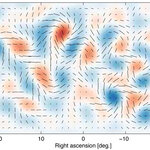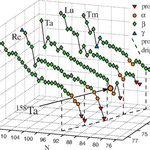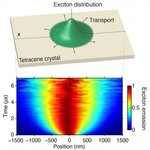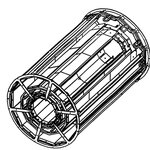Physics

The universe we can see is made up of billions of galaxies, each containing anywhere from hundreds of thousands to hundreds of billions of stars.
Large numbers of galaxies are elliptical in shape, red and mostly made up of old stars. Another (more familiar) type is the spiral, where arms wind out in a blue thin disk from a central red bulge.
On average stars in spiral galaxies tend to be much younger than those in ellipticals.
Now a group of astronomers led by Asa Bluck of the University of Victoria in Canada have found a (relatively) simple relationship between the color of a galaxy and…

Relativity says that spacetime is smooth, and only big things can warp it, in ways that are exactly known. Quantum theory says that the smallest parts of the universe are constantly fluctuating and dramatically uncertain. How can something be both smooth and fluctuating, both exact and uncertain?
How, in other words, can we make a quantum theory of gravity? It's unknown. String theory and loop quantum gravity have tried, but a unified theory has remained out of reach.
Enter – of all things – condensed matter physics.
Perimeter Institute Associate Faculty member Sung-Sik Lee is a condensed…

Quantum mechanics is able to effectively explain three of the four fundamental forces of the Universe - electromagnetism, weak interaction and strong interaction - but it does not explain gravity, which is currently only accounted for by general relativity, which is classical physics.
Identifying a plausible model of quantum gravity - a description of gravity within a quantum physics framework - is one of the major challenges physics is facing today. Despite many, many, many hypothetical models proposed to date, none has proved satisfactory or, more importantly, amenable to empirical…

Last month, scientists announced the first hard evidence for cosmic inflation, the process by which the infant universe swelled from microscopic to cosmic size in an instant.
While this almost unimaginably fast expansion was theorized more than three decades ago, there had been no evidence. Then researchers from the BICEP2 collaboration announced the first direct evidence for cosmic inflation and the first images of gravitational waves, or ripples in space-time, described as the "first tremors of the Big Bang."
The theoretical community is abuzz but that isn't meaningful to the public;…

Our universe is eternal, expanding indefinitely, and not threatened by any form of 'heath death'. All evidence points into this direction. In fact, at the end of the nineteenth century Ludwig Boltzmann had collected all the evidence to draw such conclusions. His consistent reasoning on how to render the reversible laws of physics compatible with the second law of thermodynamics brought him close, but he failed to make the final decisive steps.
Ok, I realize that at Boltzmann's time our knowledge of the universe didn't stretch beyond the Milky Way, the island of stars that we inhabit. And yes…

The confirmation of the Higgs boson and what it can tell us about the origins of mass is getting all of the attention but there are scientific mysteries about less-understood forces that may also be keys to figuring out natural laws.
Among these is quantum turbulence, the chaotic motion - at very high rates - of fluids that exist at temperatures close to zero. Observers as far back as Leonardo da Vinci have studied turbulence, a complex state of fluid motion. He observed that water falling into a pond creates eddies of motion, thus realizing that the motion of water shaped the landscape…

Identifying the full extent of the nuclear landscape, essentially how many isotopes exist, is vital for nuclear physics.
There is a lot left to learn. Beyond the stable nuclei that we find on Earth, there are many unstable nuclei that are formed in stellar events such as supernovae, but which are short-lived. There is a limit to how many protons and neutrons a nucleus can hold – too many and the excess will literally ‘pop out’. These limits are known as the proton and neutron ‘drip lines’.
Although these drip lines can be calculated, getting experiments to agree is another issue. Even…

Do BICEP2 data provide a proof of cosmic inflation? As early as March 17, a Stanford report asserted « New evidence from space supports Stanford physicist's theory of how universe began ». A Scientific American blog reported « Shocked Physicist Learns His Big Bang Theory Is True [Video] », and Nature wrote « Telescope captures view of gravitational waves. Images of the infant Universe reveal evidence for rapid inflation after the Big Bang ». Things, however, are not that simple.
The Stanford claim has already been clearly contradicted in my note « BICEP2, CMB B-modes And Spinorial Space-time…

A quasiparticle called the exciton is responsible for the transfer of energy within devices, such as solar cells, LEDs, and semiconductor circuits, and has been understood for decades, but exciton movement within materials has never been directly observed.
An exciton, which travels through matter as though it were a particle, pairs an electron, which carries a negative charge, with a place where an electron has been removed, known as a hole. Overall, it has a neutral charge, but it can carry energy. For example, in a solar cell, an incoming photon may strike an electron, kicking it to a…

Below is a clip from a chapter of my book where I describe the story of the silicon microvertex detector of the CDF experiment. CDF collected proton-antiproton collisions from the Tevatron collider in 1985, 1987-88, 1992-96, and 2001-2011. Run 1A occurred in 1992, and it featured for the first time in a hadron collider a silicon strip detector, the SVX. The SVX would prove crucial for the discovery of the top quark.Soon after the start of Run 1A a meeting was held at Fermilab to discuss the operational status of the SVX. There were great expectations to see how well the silicon performed. One…